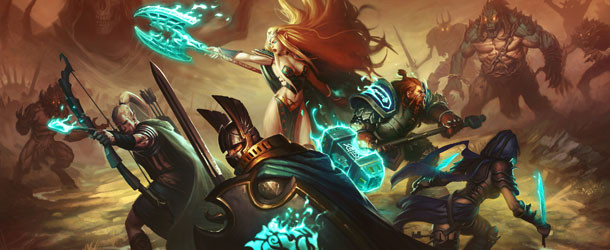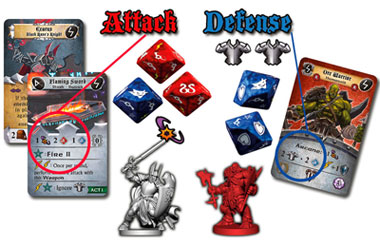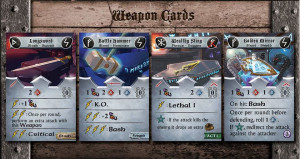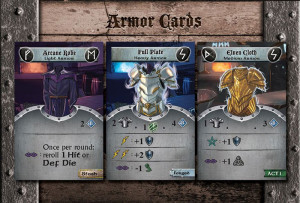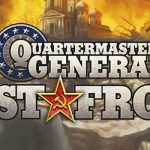It is not a peaceful world. Centuries of war have given way to countless battles, ferocious raids and stalwart defenses, the hidden knife in the dark, the charging of orcs on the dusty road. No, there is no peace for our Heroes; born in battle, died in battle, and resurrected to do battle again.
The combat system in Sword & Sorcery is fast and deadly. It is based on special, custom 10-sided dice that come in two different colors, red and blue. The red dice are used during attacks only, while the blue dice are used for both attack and defense. The dice are marked with special symbols instead of numbers, and each symbol has its own meaning during a fight.
Attack
When a hero or a monster uses an activity to Attack a target, the combat rules come to life. An attack can be performed with any weapon equipped by a hero (or a weapon or natural weapon, per the monster description). All weapons have a Range: if the range is 0, then the weapon can be used only to attack targets in the attacker’s area; otherwise, the weapon can attack targets in Line of Sight and range of the weapon (weapon ranges are measured in areas).
There are two stages in any attack in Sword & Sorcery. The first stage is called the HIT stage, and represents the attempt to hit the target. The HIT includes three steps.
Step 1: Roll dice. The attacker rolls a number of red and/or blue dice based on the weapon used and any other bonus or penalty. Certain hits may be added, if the weapon or any other action dictates.
Step 2: Apply effects. If the rolled dice show special results (such as a bolt or a pentagram), the attacker may use them to apply any special effect. Most special effects cannot be applied more than once in a single attack, and any reroll cannot be performed more than once. Any effect chosen now must be applied before the DEFENSE Stage begins.
Step 3: Summarize hits. The attacker adds up all hits inflicted with his roll, including any and all bonuses, special effects, special actions, and so on. Once done, the HIT stage is over, and the DEFENSE stage begins.
Defense
The DEFENSE stage includes six steps, based on the defender’s characteristics and abilities.
Step 1: Weaknesses and resistances. Some enemies may be resistant to specific types of damage, and some hero spells may enhance their own defenses. Other enemies may be vulnerable to specific attacks. Any special weakness or resistance is noted in this step, reducing or increasing the total number of hits calculated in the HIT stage.
Step 2: Armor. Natural armor, special resistance, or a suit of armor may absorb some damage, and in this step some hits may be canceled by armor. Armor cannot be used if the defender is KOed.
Step 3: Magic shield. Each point of magic shield cancels one hit, and is expended until the refresh phase.
Step 4: Roll DEF dice. The defender now rolls one blue die for each uncancelled hit, up to a specific maximum stated on the enemy or hero card(s).
Step 5: Apply effects. Some defensive items and some creatures have special defensive effects that may activate after the DEF dice are rolled, such as rerolling failed DEF dice. Such effects are applied during this step.
Step 6: Summarize shields. Calculate the total number of shield icons rolled. Each shield cancels one hit. Any unblocked hit at the end of this step reduces the defender’s current HP total by 1.
Some damage may be critical: in this case, instead of inflicting damage, the hit becomes a critical effect. The attacker draws one Critical counter and applies the effects.
Heroes may also use their action to Focus an Attack, gaining an extra hit in Step 1.
Also, supremacy in battle counts: figures belonging to the side which has supremacy in the area always inflict one extra hit during attacks (in Step One).
Some items and powers may also be used to attack, and are marked with a damage type keyword: arcane, bludgeoning, piercing or slashing.
Combat is a brutal affair, and there is no kindness or courtesy. Evil forces will not concede, will not surrender, and will never take prisoners. They have no pity, no remorse. Heroes must be strong and use their skills to the best of their ability during combat to achieve individual victory, freed the land, and gain back their lost souls.
To see the previous articles: Part 1 (Overview), Part 2 (The Heroes), Part 3 (The Enemies).

